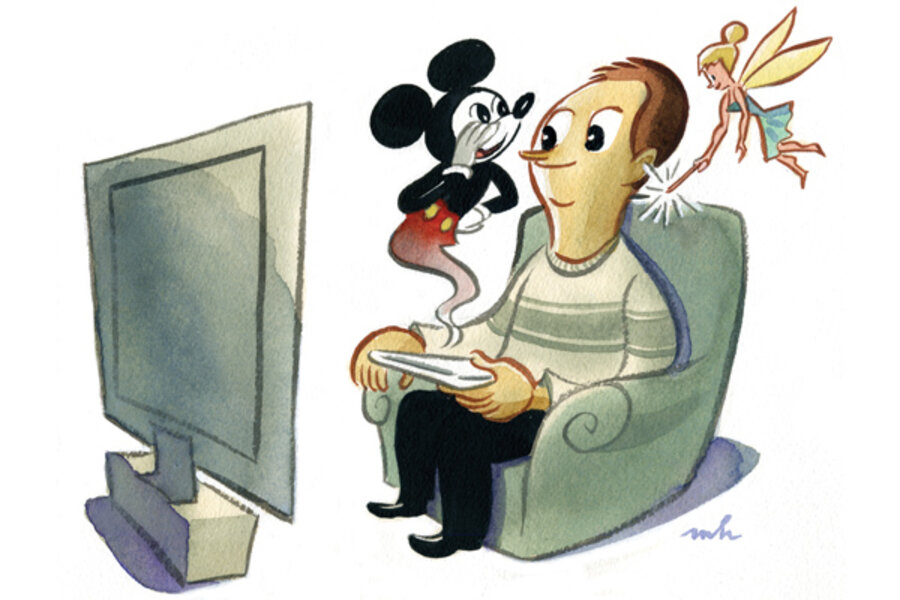'Second screen' apps turn digital distractions into TV companions
Loading...
When KC Orcutt watches television, she rarely just watches the television. Her eyes bob between the screen and her phone.
The writer from Albany, N.Y., uses her smart phone to check e-mail, read websites, and comment on movies while she watches them.
"I judge a movie by how often I check my phone," she says.
According to studio executives and advertisers, Ms. Orcutt is part of the problem.
Forty percent of tablet and smart phone owners in the United States use those devices daily while watching TV, according to the research firm Nielsen in New York. More than 85 percent pull double duty at least once a month. And these distracted moments aren't confined to commercial breaks. Nielsen found that multitaskers are just as likely to use their phones or tablets during the program as during the ads.
Rather than compete with these devices, Disney is experimenting with ways to occupy both screens concurrently. It has developed "second screen" applications, software designed to complement television. Part director commentary, part online forum, these apps try to keep people like Orcutt invested in a TV show or movie – even when they're ignoring that TV show or movie.
"People can now interact with features about the making of the movie in ways that have not been possible on DVD or even Blu-ray," says Ole Lutjens, chief creative officer at MX, which creates second-screen apps, in San Francisco. "You can interact with it. You can take it with you. Share it with friends."
MX designed companion software for the Blu-ray releases of Disney's "The Lion King," "Tron: Legacy," and "Real Steel." As viewers watch the movie, their iPads or laptops show bonus features specifically timed to the movie – similar to VH1's "Pop Up Video" but on a separate screen instead of obscuring the primary one.
These Disney apps run through concept art, behind-the-scenes video, 3-D models, and games for kids. If the add-ons pull people in, a single tap will pause the movie or resync the app to match the video.
Disney's second-screen apps are free of charge but require a code that proves viewers purchased the corresponding Blu-ray disc. Once unlocked, the app will work whether or not people watch the movie.
Mr. Lutjens considers MX's approach – turning the iPad into an interactive art book – to be one of three second-screen strategies. Beyond curated extras, there are adaptive apps – where a computer searches the Internet to find related information on whatever viewers might be watching – and social check-in apps – where people announce what they're watching and strike up conversations about those shows.
Several services, including Umami, Yap.tv, and BuddyTV Guide, blend the adaptive and social approaches. For example, Yahoo's IntoNow identifies what people watch on the fly, whether live programming, news broadcasts, recorded shows, or Netflix streaming video. It then pulls up actor profiles, related stories, and discussions with other users.
The free app has racked up 3 million downloads across iPhone, iPad, and Android devices. The company says hundreds of thousands of people load up IntoNow during big events, such as the Academy Awards or a Super Bowl.
Unlike Disney's behind-the-scenes peeks, almost all of the information on IntoNow is available elsewhere. But Adam Cahan, who founded IntoNow and remains at the helm since Yahoo bought the company last year, says that his app better addresses why people turn to second screens.
TV did not get less interesting, boring viewers into fiddling with their phones. Social networking and quick research got more interesting, luring people back to the Web.
"What happens when you start creating one-off applications – one app for each TV show and movie – is you're just fragmenting," says Mr. Cahan. Anyone who gravitates to Facebook while watching TV may still do so while using a curated app. Better to incorporate such features into a single service, he says.
But watching how people use IntoNow may also support Disney-style second-screen apps, if they're compelling enough. Cahan says that user activity rises during big games and award shows, events that do not require constant attention. But there are large dips during well-written dramas, followed by a burst of activity once the show ends. It seems device owners can contain themselves for quality content.
As more data emerges, advertisers are slowly changing their tune about second screens. Nielsen found that 1 in 5 TV two-timers use their devices to look up products that they saw in ads, and people are more likely to remember brands if they appear on multiple screens.
For more on how technology intersect daily life, follow Chris on Twitter @venturenaut.





